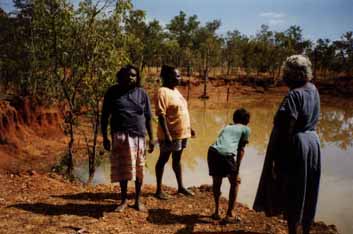
The language and its speakers
 |
The Wagiman online dictionary The language and its speakers |
| Welcome | Dictionary | About the dictionary | Language & speakers | Wagiman texts | Links & references |
[Introduction | Country and recent history | Wagiman people now | The sounds of Wagiman | The grammar of Wagiman]

Wagiman is an Australian Aboriginal language spoken in Australia's Northern Territory. At the moment there are about ten people who speak Wagiman, mostly old people. Wagiman belongs to what linguists call the non-Pama-Nyungan language family. Within that family, it appears to fall into the Gunwinyguan language group, but it is not closely related to any other Aboriginal languages.
There are several dialects of Wagiman, with the most prominent distinction being between matjjin no-roh-ma 'light language' and matjjin gu-nawutj-jan 'heavy language'. Helen Liddy and Lenny Liddy speak light language, and Lulu Martin, Paddy Huddlestone and Clara McMahon speak heavy language. There is not all that much difference, and no Wagiman speakers have any trouble understanding one another.
 |
Wagiman country is large and well-watered, extending south-west from Pine Creek, and spanning the Daly River, which the Wagiman call Guwardagun. Before the arrival of Europeans, there were perhaps about five hundred to a thousand people who spoke Wagiman. But a gold rush in Pine Creek in the 1880-90s, and then the pastoral industry, brought large numbers of immigrants to the area. Between about 1880 and 1920, new diseases introduced by Europeans, along with European violence and the introduction of alcohol, decimated the populations of all the language groups of Darwin and its hinterland. Since the 1920s, most Wagiman people have spent their lives working on the cattle stations of the area, particularly Oolloo, Douglas, Claravale, Dorisvale and Jindare. These stations probably lie for the most part roughly on traditional Wagiman country. |
 Nowadays many Wagiman people live at Kybrook Farm, just outside of Pine Creek. Others live in Pine Creek itself, and a few live further afield, elsewhere in the Northern Territory. The few fluent speakers of Wagiman sometimes use the language among themselves, but it is fairly rare to hear it spoken nowadays. Some younger people have a passive understanding of the language; they can understand it when they hear it spoken, but they don't speak it themselves. Children tend to know only a few words. Most Wagiman people now communicate in Kriol or Aboriginal English.
Nowadays many Wagiman people live at Kybrook Farm, just outside of Pine Creek. Others live in Pine Creek itself, and a few live further afield, elsewhere in the Northern Territory. The few fluent speakers of Wagiman sometimes use the language among themselves, but it is fairly rare to hear it spoken nowadays. Some younger people have a passive understanding of the language; they can understand it when they hear it spoken, but they don't speak it themselves. Children tend to know only a few words. Most Wagiman people now communicate in Kriol or Aboriginal English.
The entries and examples in the dictionary are written using a spelling system (orthography) designed by Mark Harvey. It is a practical orthography which uses only letters from the English alphabet.
Some letters represent sounds in Wagiman which are very similar to sounds in English. The simple consonants are:
b, p, d, t, j, g, k, m, n, l, r, w, y.
All but one of the other consonants are represented by sequences of two letters, which are called digraphs. Here are the rest of the consonants, with brief explanations of the sounds they represent:
And finally, there are five vowels:
Like all the languages of the world, Wagiman has a very complex grammar. Here we will look at just a few particularly important features.
Most words in Wagiman are made up of a number of parts. These parts of words are called morphemes. In the entries and examples in the dictionary, hyphens are used to show how words are divided into morphemes.
Nouns - naming words - often have morphemes attached to the end of them which give more information about the noun. We will briefly look at two examples:
In this example, the noun danganyin, which means 'tucker' has -gu on the end. This is called the dative case and it means that they looked 'for' tucker.
Here is a second example:Wagiman verbs - doing words - are always made up of a number of parts. There are usually at least three morphemes. The first shows who did the action, the second shows what the action was, and the third shows when the action happened. For an example, have a look at this sentence:
Another interesting fact about Wagiman grammar is that you can put the words in a sentence together in almost any order, and you will still be understood. Consider this example:
As was written above, the grammar of Wagiman is very complex, and these few brief words hardly do it justice! To find out more about the grammar of Wagiman, you might want to look at some of the books listed on the Links and references page.
[Welcome | Dictionary | About the dictionary | Language & speakers (top) | Wagiman texts | Links & references]